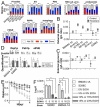Integrative Analysis of the Ethanol Tolerance of Saccharomyces cerevisiae
- PMID: 36982719
- PMCID: PMC10051466
- DOI: 10.3390/ijms24065646
Integrative Analysis of the Ethanol Tolerance of Saccharomyces cerevisiae
Abstract
Ethanol (EtOH) alters many cellular processes in yeast. An integrated view of different EtOH-tolerant phenotypes and their long noncoding RNAs (lncRNAs) is not yet available. Here, large-scale data integration showed the core EtOH-responsive pathways, lncRNAs, and triggers of higher (HT) and lower (LT) EtOH-tolerant phenotypes. LncRNAs act in a strain-specific manner in the EtOH stress response. Network and omics analyses revealed that cells prepare for stress relief by favoring activation of life-essential systems. Therefore, longevity, peroxisomal, energy, lipid, and RNA/protein metabolisms are the core processes that drive EtOH tolerance. By integrating omics, network analysis, and several other experiments, we showed how the HT and LT phenotypes may arise: (1) the divergence occurs after cell signaling reaches the longevity and peroxisomal pathways, with CTA1 and ROS playing key roles; (2) signals reaching essential ribosomal and RNA pathways via SUI2 enhance the divergence; (3) specific lipid metabolism pathways also act on phenotype-specific profiles; (4) HTs take greater advantage of degradation and membraneless structures to cope with EtOH stress; and (5) our EtOH stress-buffering model suggests that diauxic shift drives EtOH buffering through an energy burst, mainly in HTs. Finally, critical genes, pathways, and the first models including lncRNAs to describe nuances of EtOH tolerance are reported here.
Keywords: CRISPR–Cas9; data integration; lncRNAs; lncRNA–protein interactions; membraneless organelles; omics; systems biology.
Conflict of interest statement
The authors declare no conflict of interest.
Figures







References
MeSH terms
Substances
Grants and funding
LinkOut - more resources
Full Text Sources
Molecular Biology Databases
Research Materials

